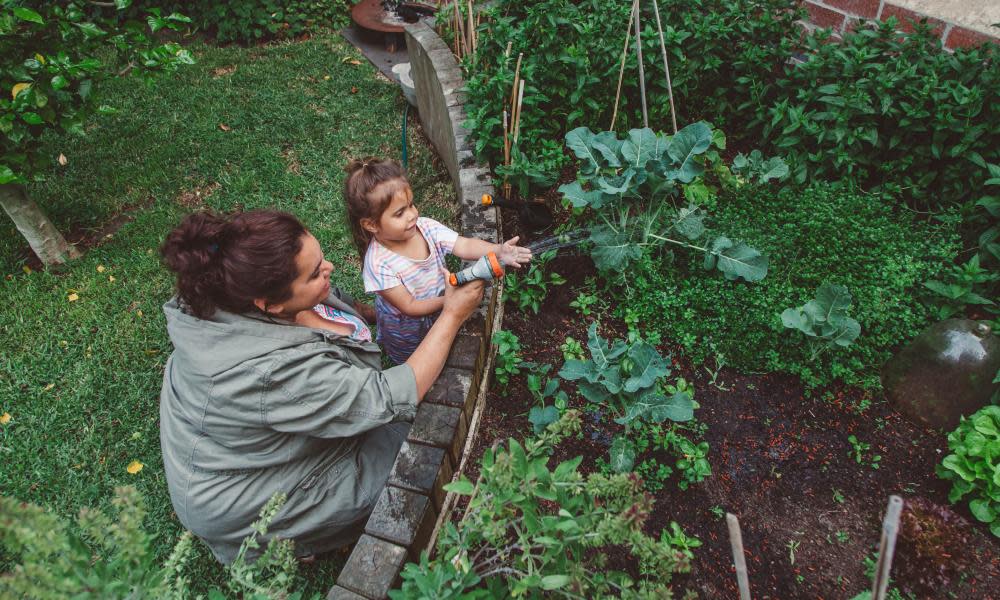Protecting your garden in heatwaves: 'Bust that myth around watering in the middle of the day'

This summer in Australia, plants are thriving, well-watered thanks to natural rainfall.
The current La Nina weather pattern’s deceptive lull in temperatures has meant we’ve had less record-breaking hot days lately, though 2020 was Australia’s fourth hottest summer on record.
But take your mind back a year or two and drought was the norm. Sweltering days made plants go backwards or die – and those hot days are sure to return. Fortunately, from plant selection and irrigation timing, to your choice of pot and pre-heat product applications, there are ways that you can prepare your garden for a hotter future.
Water, and water again
Heed the “It’s gonna be a hot one tomorrow” weather conversation, as that information signals time to take action. Water the night before a predicted heatwave. Give plants a decent drink, enough to penetrate the root zone, then get up early before the heat rises on the day and do it again. Make sure your hose is on a shower setting, so that the act of watering is gentle and not soil-disturbing.
According to Dr Brett Summerell, The Royal Botanic Gardens Chief Botanist, we also need to “bust that myth around watering in the middle of the day. If the plant is short of water, try and avoid the foliage [as that can cause leaf burn], but there is nothing wrong with carefully watering to the soil and root system, to alleviate heat stress”.
Mulch and wind protection
Beside the intensity of the heat during a heatwave, the accompanying hot winds remove traces of moisture in a flash. In order to retain it, you need a layer of mulch between 20mm and 75mm thick, depending on the material.
Organic mulches, like chunky wood, lucerne or pea straw or inorganic mulches like pebbles, will achieve varying levels of moisture retention. Dr Summerell says, “Reflective and lighter coloured mulches won’t store as much heat. While pebble mulch is okay for succulents aesthetically … it does get much hotter than straw mulches”.
Related: Garden short cuts? No thanks | James Wong
Pick the right plants
Although English gardens might appeal, Australia’s proximity to the equator means many of those plants just aren’t suitable for our climate. Succulents and cacti are brilliant choices for Australian gardens, as are plants from the Mediterranean and even South Africa.
These are adapted to periods of dry and intense heat and make sustainable choices for Australian gardens. Whatever plant choice you make, Dr Summerell’s reminder should be taken to heart, “Even a succulent will survive periods of being dry, but if you want it to look flash and fabulous, it needs regular watering”. If you are growing edibles, during heatwaves, they may require watering more than once a day, to avoid bitter, inedible crops.
And the right pots
Terracotta looks beautiful, but left unsealed, it loses moisture fast, particularly in hot winds. Seal pots with a terracotta sealant from a hardware store, or select pots that are sealed and lighter in colour, so they reflect more of the heat. Common black plastic pots absorb heat. Plants in pots have the advantage of being movable. Put them in a shaded spot before the heat strikes to ensure happier plants.
Create shade
Plants that are situated in garden beds will benefit from a temporary shade structure. A beach umbrella is perfect for the job. There are all sorts of shade structures that are commercially available, or you can also get some shade cloth and tomato stakes and make your own.
You want to protect from the particularly bitey midday and afternoon sun – it’s the latter part of the day where you will see wilting and scorching of plants occur, making them look brown, burnt, shrivelled and dead on the ends in the days following a heatwave. Easterly or morning sun is tame in comparison.
Helpful products
There are leaf sprays and products that you can add to a watering can and apply to your plants regularly, which protect them more than watering alone. They all need to be part of your plant-care regime before the heat strikes.
Water crystals that absorb and hold moisture can be added around the root zone when you are potting plants up – make sure they are pre-expanded though, so you can judge the quantity required and never sprinkle on the top of the pot – this will suck all the moisture out of the plant’s root zone altogether!
Yates Drought Shield adds a polymer coating to the leaf that protects from damaging environmental conditions. Eco Organic Gardening’s Eco-Hydrate works through the soil, as a wetting agent and moisture attractant. It ensures the water penetrates to the root of the plants and encourages them to take up more water than they would ordinarily.
Research has proven that regular applications of plant tonics made from seaweed concentrate encourages stronger root growth and plant health, so that they take environmental extremes like heat, drought and frost in their stride. Seasol Super Soil Wetter and Conditioner adds nutrients to the soil while including soil conditioners and wetting agents in one product. Keep a saucer under pots when you apply it, as the brown-coloured liquid can leak on to tiles.
Though it’s not advised year-round, on days of extreme heat, potted plants can draw on the excess water in the saucer to keep themselves hydrated and ensure they make it through.


